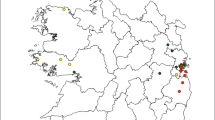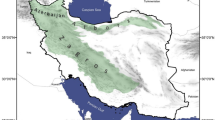Abstract
Honeys in Chile are produced from native and endemic plant species that, due to phenolic compounds, present beneficial biological attributes. However, certain undesirable pollutants can exist in honeys from beehives located near agricultural crops or commercial industries. Neonicotinoids are a widely used pesticide group in farming, despite acute, negative effects to bee health. Indeed, neonicotinoids are associated with colony collapse disorder, one of the main causes for increased death rates in bee populations. Declining bee health in Chile may consequently be related to neonicotinoids exposure. To assess this threat, honey samples collected from different regions in Chile were analyzed to quantify phenolic contents, antioxidant activity, and the presence of four neonicotinoids (i.e., thiamethoxam, thiacloprid, acetamiprid, and imidacloprid). Pesticide-free honey samples were also fortified with three concentrations of the four neonicotinoids to evaluate changes in the chemical properties of honey. Total phenol contents decreased and antioxidant activity increased in relation to the assessed fortification concentrations. Since the agricultural use of neonicotinoids has been related to those negatives damages for bee health, in Chile, beehives should be strategically located to prevent the contamination of honeys with neonicotinoid pesticides.



Similar content being viewed by others
References
Al Naggar Y, Codling G, Vogt A, Naiem E, Mona M, Seif A, Giesy JP (2015) Ecotoxicology and Environmental Safety Organophosphorus insecticides in honey, pollen and bees (Apis mellifera L.) and their potential hazard to bee colonies in Egypt. Ecotoxicol Environ Saf 114:1–8
Aliouane Y, el Hassani AK, Gary V, Armengaud C, Lambin M, Gauthier M (2009) Subchronic exposure of honeybees to sublethal doses of pesticides: effects on behavior. Environ Toxicol Chem 28(1):113–123
Arena M, Sgolastra F (2014) A meta-analysis comparing the sensitivity of bees to pesticides. Ecotoxicology 23(3):324–334
Barganska Z, Slebioda M, Namiesnik J (2013) Pesticide residues levels in honey from apiaries located of Northern Poland. Food Control 31(1):196–201
Bertoncelj J, Doberšek U, Jamnik M, Golob T (2007) Evaluation of the phenolic content, antioxidant activity and colour of Slovenian honey. Food Chem 105(2):822–828
Blacquière T, Smagghe G, Van Gestel CAM, Mommaerts V (2012) Neonicotinoids in bees: a review on concentrations, side-effects and risk assessment. Ecotoxicology 21(4):973–992
Buratti S, Benedetti S, Cosio MS (2007) Evaluation of the antioxidant power of honey, propolis and royal jelly by amperometric flow injection analysis. Talanta 71(3):1387–1392
Codex Alimentarius Commission FAO/OMS (2001) Revised Codex Standard for Honey, Standards and Standard Methods. Codex Aliment Comm FAO. OMS. http://www.fao.org/input/download/standards/310/cxs_012e.pdf
Ecobichon DJ (2001) Pesticide use in developing countries. Toxicology 160(1):27–33
EFSA (2013a) Conclusion on the peer review of the pesticide risk assessment for bees for Clothianidin. EFSA J 11(1):1–58
EFSA (2013b) Conclusion on the peer review of the pesticide risk assessment for bees for the active substance thiamethoxam. EFSA J 11(1):12–68
EFSA (2013c) Conclusion on the peer review of the pesticide risk assessment for bees for the active substance imidacloprid. EFSA J 11(1):1–55
El Hassani AK, Dacher M, Gary V, Lambin M, Gauthier M, Armengaud C (2008) Effects of sublethal doses of acetamiprid and thiamethoxam on the behavior of the honeybee (Apis mellifera). Arch Environ Contam Toxicol 54(4):653–661
Elgueta S, Moyano S, Sepúlveda P, Quiroz C, Correa A (2017) Pesticide residues in leafy vegetables and human health risk assessment in North Central agricultural areas of Chile. Food Addit Contam B 10(2):105–112
Fontaine C, Dajoz I, Meriguet J, Loreau M (2006) Functional diversity of plant-pollinator interaction webs enhances the persistence of plant communities. PLoS Biol 4(1):0129–0135
Food and Agriculture Organization of the United Nations (2003) Committee on Agriculture. Seventeenth Session. Development of a Framework for Good Agricultural Practices
Grembecka M, Szefer P (2013) Evaluation of honeys and bee products quality based on their mineral composition using multivariate techniques. Environ Monit Assess 185(5):4033–4047
Kasiotis KM, Anagnostopoulos C, Anastasiadou P, Machera K (2014) Pesticide residues in honeybees, honey and bee pollen by LC-MS/MS screening: reported death incidents in honeybees. Sci Total Environ 485–486(1):633–642
Klatt BK, Holzschuh A, Westphal C, Clough Y, Smit I, Pawelzik E, Tscharntke T (2014) Bee pollination improves crop quality, shelf life and commercial value. Proc Biol Sci 281(1775):20132440
Kroyer G, Hegedus N (2001) Evaluation of bioactive properties of pollen extracts as functional dietary food supplement. Innov Food Sci Emerg Technol 2(3):171–174
Kujawski MW, Namieśnik J (2011) Levels of 13 multi-class pesticide residues in Polish honeys determined by LC-ESI-MS/MS. Food Control 22(6):914–919
Loveaux J, Maurizio A, Vorwohl G (1978) Methods of melissopalynology. Bee World 59:139–152
Lu C, Warchol KM, Callahan RA (2014) Sub-lethal exposure to neonicotinoids impaired honey bees winterization before proceeding to colony collapse disorder. Bull Insectol 67(1):125–130
Mitchell EAD, Mulhauser B, Mulot M, Mutabazi A, Glauser G, Aebi A (2017) A worldwide survey of neonicotinoids in honey. Science 358:109–111
Mogren CL, Lundgren JG (2016) Neonicotinoid-contaminated pollinator strips adjacent to cropland reduce honey bee nutritional status. Sci Rep 6:29608. https://doi.org/10.1038/srep29608
Montenegro G, Gómez M, Díaz-forestier J, Pizarro R (2008a) Aplicación de la Norma Chilena Oficial de denominación de origen botánico de la miel para la caracterización de la producción apícola. Ciencia e Investigación Agraria 35(2):181–190
Montenegro G, Gomez M, Díaz-Forestier J, Pizarro R (2008b) Application of the Chilean Official Standard to designate the botanical origins of honey for the characterization of the apicultural production. Cien Inv Agr 35:181–190
Panseri S, Catalano A, Giorgi A, Arioli F, Procopio A, Britti D, Chiesa LM (2014) Occurrence of pesticide residues in Italian honey from different areas in relation to its potential contamination sources. Food Control 38(1):150–156
Przybyłowski P, Wilczyńska A (2001) Honey as an environmental marker. Food Chem 74(3):289–291
Rice-Evans CA, Miller NJ, Paganga G (1996) Structure-antioxidant activity relationships of flavonoids and phenolic acids. Free Radic Biol Med 20(7):933–956
Sanchez-Bayo F, Goka K (2014) Pesticide residues and bees—a risk assessment. PLoS ONE 9(4):e94482
Sharma RK, Upadhyay G, Siddiqi NJ, Sharma B (2013) Pesticides-induced biochemical alterations in occupational North Indian suburban population. Hum Exp Toxicol 32(11):1213–1227
Singleton V, Rossi J (1965) Colorimetry of total phenolics with phosphomolybdic–phosphotungstic acid reagent. Am J Enol Vitic 16:144–158
USDA (2018) Honey Bee Colonies. National Agricultural Statistics Service (NASS), Agricultural Statistics Board, United States Department of Agriculture (USDA). https://downloads.usda.library.cornell.edu/usdaesmis/files/rn301137d/jq085n95f/mc87pt22m/BeeColonies-08-01-2018.pdf. Accessed 24 Nov 2018
vanEngelsdorp D, Evans JD, Saegerman C, Mullin C, Haubruge E, Nguyen BK, Frazier M, Frazier J, Cox-Foster D, Chen Y, Underwood R, Tarpy DR, Pettis JS (2009) Colony collapse disorder: a descriptive study. PLoS ONE 4(8):e6481
vanEngelsdorp D, Traynor KS, Andree M, Lichtenberg EM, Chen Y, Saegerman C, Cox-Foster DL (2017) Colony Collapse Disorder (CCD) and bee age impact honey bee pathophysiology. PLoS ONE 12(7):e0179535
Williamson S, Wright A (2013) Exposure to multiple cholinergic pesticides impairs olfatory learning and memory in honeybees. J Exp Biol 216:1799–1807
Wirtz IP, Hauer-Jakli M, Schenke D, Ladewig E, Märländer B, Heimbach U, Pistorius J (2018) Investigations on neonicotinoids in guttation fluid of seed sugar beet: frequency, residue levels and discussion of the potential risk to honey bees. Crop Prot 105:28–34
Author information
Authors and Affiliations
Corresponding author
Ethics declarations
Conflict of interest
No potential conflicts of interest were reported by the authors.
Rights and permissions
About this article
Cite this article
Mejias, E., Gómez, C., Garrido, T. et al. Natural attributes of Chilean honeys modified by the presence of neonicotinoids residues. Agroforest Syst 93, 2257–2266 (2019). https://doi.org/10.1007/s10457-019-00345-z
Received:
Accepted:
Published:
Issue Date:
DOI: https://doi.org/10.1007/s10457-019-00345-z




